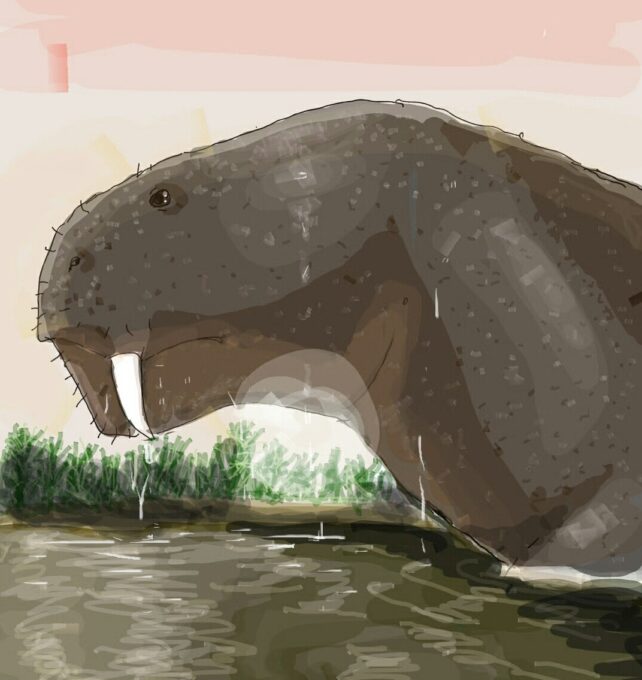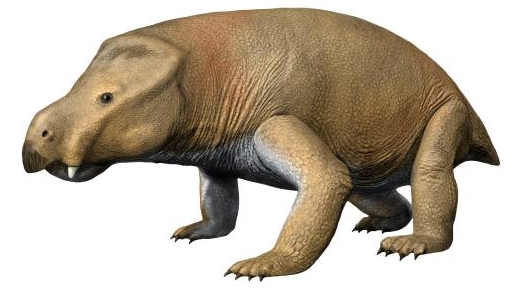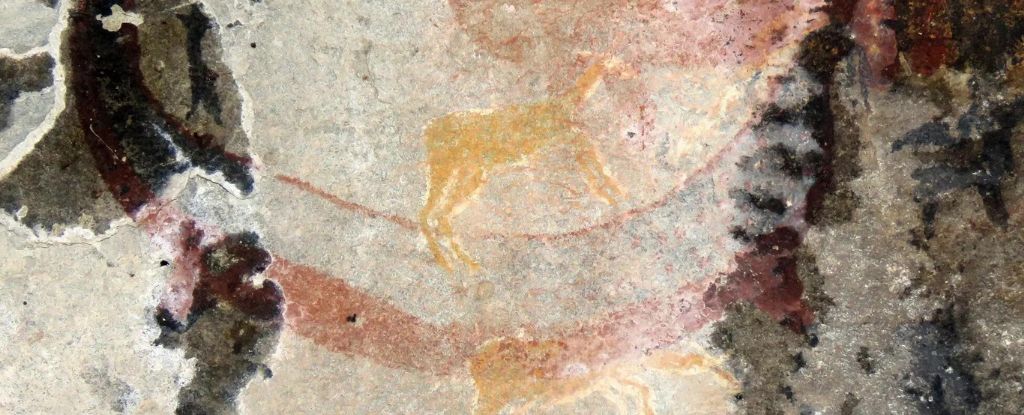Indigenous people in southern Africa may have been painting long-extinct creatures from 260 million years ago, even before Western archaeologists described the fossils.
In a thought-provoking new paper, evolutionary biologist Julien Benoit argues that the rock paintings of La Belle France in the Free State Province of South Africa are an overlooked form of Indigenous paleontology.
The depiction of a tusked animal, which was painted nearly two centuries ago, is probably not a made-up creature, Benoit explains, but a recreation of a beast that once lived in the region more than 260 million years ago.
In the painting, the creature is long and thin, which is why the rock panel is called the Horned Serpent.
But Benoit, who works at the University of the Witwatersrand in South Africa, has a different perspective. He says the animal resembles a dicynodont – a four-legged, toothless and tusked ancestor of today’s mammals, whose fossils are abundant and conspicuous in the Karoo Basin.
This basin is described by some as a “palaeontological wonderland“. It covers much of what we now know as South Africa, although the fossils deposited here came from before the Gondwana supercontinent broke up.

Benoit argues that the rock wall painting of a toothed creature, made by the ǀXam-ka ǃʼē people, is suggestive of a ‘geomyth’ – an oral or written tradition used to explain geological events and phenomena, like fossils or natural features of the landscape.
The curve of the creature’s spine is reminiscent of the ‘death pose’ often seen in the fossil arrangements of dicynodonts.
“The painting was made in 1835 at the latest, which means this dicynodont was depicted at least ten years before the western scientific discovery and naming of the first dicynodont by Richard Owen in 1845,” says Benoit.
“This work supports that the first inhabitants of southern Africa… discovered fossils, interpreted them and integrated them in their rock art and belief system.”
According to reporting from The New York Times, Benoit first noticed the resemblance between the Horned Serpent and a dicynodont in a book from the 1930s. When he went to see the original artwork for himself, he found several exposed fossils of dicynodonts in the vicinity.

The Indigenous cultures of southern Africa are known collectively as San, and according to colonist accounts, a local San myth tells of large animals, bigger than hippos or elephants, that once roamed the area.
Today, archaeological evidence suggests that San ancestors found and transported fossils like these over great distances.
In a 2019 paper, Benoit, paleontologist Charles Helm, and several other colleagues argued that there was a “rich, underappreciated body of evidence for Indigenous awareness of fossils and geological phenomena.”
In time, they predicted a “diverse non-western, Indigenous palaeontological and geomythological heritage will probably become evident in southern Africa.”
The painting of a tusked animal in Karoo is Benoit’s first fleshed-out example.

Perhaps the ǀXam-ka ǃʼē people interpreted the skulls of dicynodonts as once-living creatures, integrating the animals into their worldview and their art.
The downturned tusks on the Horned Serpent panel are pointed in the same direction as dicynodont tusks – the opposite to elephants and warthogs. In fact, no living animal in Africa has tusks like this.
“The skin of the tusked animal is dotted,” writes Benoit, “which is not unusual in San rock art, but is also consistent with the warty mummified skin preserved in some dicynodont fossils in the area.”
Benoit’s claims are almost certain to attract heavy debate over the potential for ancient cultures to interpret fossils as intact animals. Claims of protoceratop fossils inspiring myths of griffins, for example, have recently drawn criticism from researchers who point out a lack of supporting evidence.
The painting could be interpreted as a seal eating a fish or a land animal eating a snake. But the U-shape is too short for that, Benoit argues, and usually in San rock art, snakes and fish have more identifying features. The lines are also too thick to be whiskers or blood, he says.
“Even if one considers that the Horned Serpent panel has a purely spiritual meaning, it does not invalidate the hypothesis that the tusked animal itself may have been imagined based on a dicynodont fossil,” argues Benoit.
“The spiritual and paleontological interpretation of this painting are not mutually exclusive.”
The study was published in PLOS ONE.





